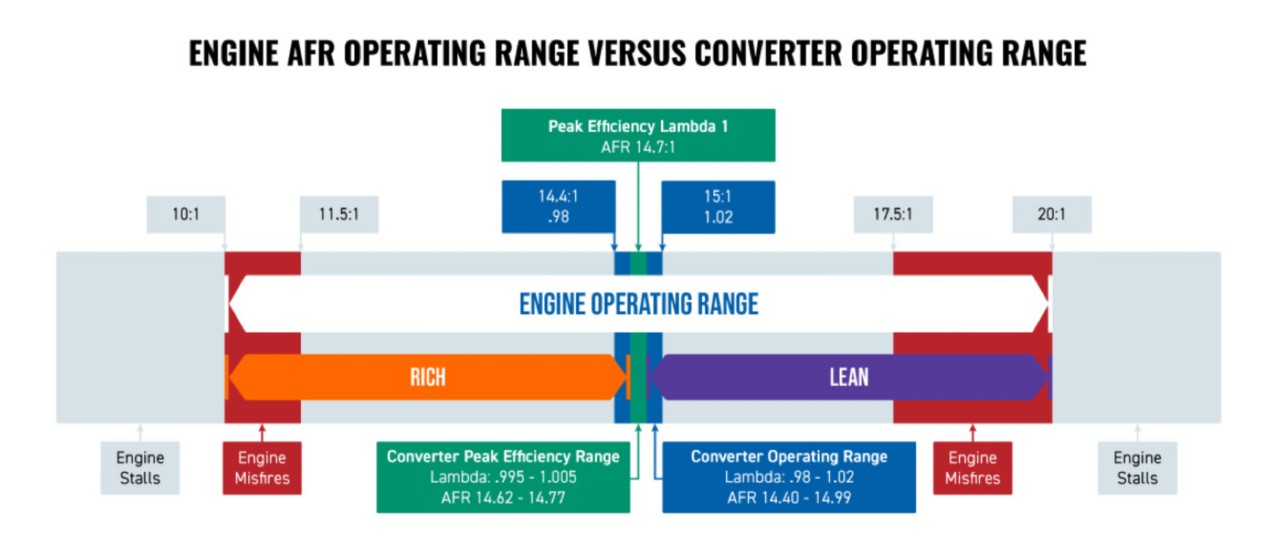Cracking the Code
A common emissions code seen in the field, a P0420 trouble code indicates that the catalytic converter isn’t functioning efficiently. To work at peak efficiency, the emissions or feed gases entering the catalytic converter need to be perfectly balanced and not excessively elevated.
To resolve the code, follow these steps:
Step 1 – Resolve Engine Trouble Codes
The first step is to resolve any other codes that may have come up in addition to the P0420; especially troublesome is the P0300 series of cylinder misfire codes. A P0300 code could be related to something in the ignition (spark plug or coil), the fuel injector, compression or fuel contamination.
Step 2 – Checking for and Resolving Exhaust System Leaks
Checking for and Resolving Exhaust System Leaks
Step 3 – Check Cylinder Imbalance
If one cylinder is running lean and the other cylinders are running rich, this is an indication that the engine has an imbalance in power output. This imbalance can create excessive emissions by raising hydrocarbon and nitrous oxide output simultaneously. Most advanced diagnostic scan tools are capable of running a cylinder imbalance test, but another way to check for cylinder imbalance is to scope the ignition pattern. In general, cylinders with short burn lines indicate lean cylinders while long burn lines indicate rich cylinders.

Step 4 – Check Spark Plugs
Another cause of elevated emissions is worn or fouled spark plugs. In order to meet stringent emission durability requirements of 80,000 or more miles, many modern vehicles come equipped with long-lasting iridium spark plugs. These long-lasting iridium spark plugs sometimes get replaced with spark plugs made of other materials and may not provide the same length of service life. As the spark plug starts to fail, emissions can start to become elevated sometimes as early as 20,000 or 30,000 miles after replacement.
Testing Converter Performance
Now that you have learned about the different steps you can take to improve converter efficiency. Next, let’s look at how to test the performance of the converter.
Graphing the Rear Oxygen Sensor
You can tell what’s going on inside of the converter by monitoring the operation of the rear oxygen sensor, which in turn monitors the performance of the converter.
Graphing the rear oxygen sensor voltage output while monitoring it under different driving conditions can give some insights as to how the converter is performing. Anytime the voltage is steady and at 450mlv or higher, this indicates good converter performance; if under any driving conditions, it can obtain a steady 450mlv or higher, replacing the converter is most likely not going to resolve the issue. The cause of the issue is most likely related to elevated emissions or imbalanced feed gases as discussed earlier. The rear oxygen sensor will drop below (swinging never holding steady) 450mlv when the feed gases entering the converter aren’t perfectly balanced.
Oxygen Storage Capacity Test
If all of the diagnostics are still pointing to an issue with the catalytic converter (the rear oxygen sensor rarely maintains a steady 450mlv or higher), the next step is to perform an oxygen storage capacity test to determine the condition of the converter. Before running the test, fully warm up the converter. Also, follow the steps above to obtain the rear oxygen sensor reading of 450mlv or above and steady at idle. Once these conditions are met, you can run the test.
Start by depleting the converter of all its oxygen by forcing the mixture to run rich and then taking away that rich condition and make it go lean. Compare the front and rear oxygen sensors to determine how long it takes to see the lean condition in the front and then how long it takes the rear oxygen sensor to see the lean condition. A two second or more delay typically indicates that the converter is operating properly and you should continue running diagnostics to understand the root cause of the converter efficiency issue.
5-Gas Analyzer
One of the easiest ways to determine what is going on inside of the converter and the emissions output of the engine is with a recently calibrated 5-gas analyzer. An analyzer will allow you to see all five emissions to quickly determine the gas balance and the cause of elevated emissions.
As an example, if hydrocarbons are elevated but the air/fuel mixture is balanced, this usually indicates worn spark plugs or low compression. If both nitrous oxide and hydrocarbon emissions are elevated, this indicates cylinder imbalance issue. Lastly, if both oxygen and hydrocarbon emissions are elevated it indicates cylinder misfires.
Remember, converters don’t fail on their own, so it’s important to resolve the root cause before replacing the converter. If all emissions are balanced and low, and converter efficiency is still an issue, it typically indicates that the converter is damaged and in need of replacement.
Learn more about quality exhaust parts, find the right car part, or find a local repair shop today.
The content contained in this article is for informational purposes only and should not be used in lieu of seeking professional advice from a certified technician or mechanic. We encourage you to consult with a certified technician or mechanic if you have specific questions or concerns relating to any of the topics covered herein. Under no circumstances will we be liable for any loss or damage caused by your reliance on any content.